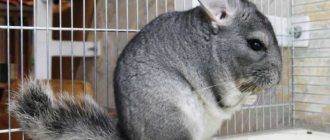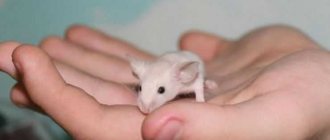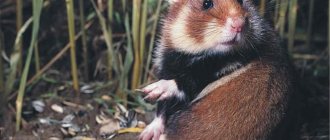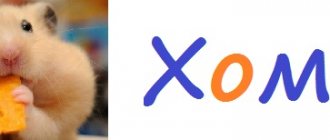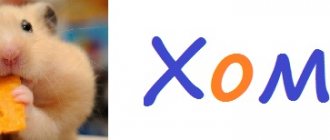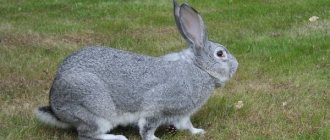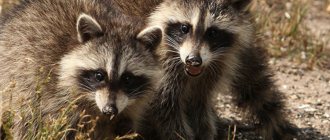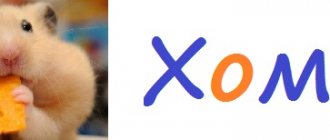08 December98306pet rodentschinchilla
The chinchilla animal is a rodent that inhabits the territory of South America. Chinchillas are known for their valuable fur, because of which their numbers have rapidly decreased and these animals are listed in the Red Book. Today the chinchilla animal is a very popular pet. Below you will find a description of the chinchilla, and you can also learn about the features of caring for and keeping a chinchilla at home.
Description of chinchilla
The chinchilla looks very cute and funny. The chinchilla animal has a large head, short neck and round body. She has large ears, a long mustache and a short tail. The chinchilla looks like a small rodent. Chinchillas range from 25 to 35 cm in length, with females being larger than males. The rodent weighs 500-700 grams.
The chinchilla looks fluffy, as if made of plush. She has soft, thick and beautiful fur. The chinchilla looks inconspicuous due to its gray-blue color and only on its belly its fur has a light gray tint. Modern colors of captive-bred chinchillas are varied and have many variations.
The description of the chinchilla includes many unusual facts about these rodents. For example, their ears have special membranes, with the help of which the animals close their ears during sand baths so that sand does not get inside. Chinchilla fur is very dense because up to 80 hairs grow from each hair follicle.
Thanks to the developed cerebellum, the chinchilla animal has good coordination and is adapted to night life. The animal's hind legs are longer than its front legs, which allows it to jump to a height of up to 2 meters. Chinchillas make many interesting sounds, they can quack, chirp, growl, squeak and click their teeth.
Where and how long do chinchillas live?
Chinchillas live for about 20 years. The homeland of these animals is South America. Under natural conditions, the chinchilla lives in the Andes of Southern Bolivia, northwestern Argentina and northern Chile. Chinchillas live in the mountains at an altitude of up to 5 km above sea level. In its natural environment, the chinchilla animal lives in rock crevices, under stones, or digs holes.
The chinchilla animal is perfectly adapted to life in the mountains. The structure of the skeleton allows the animal to crawl through even the narrowest spaces, and the developed cerebellum ensures confident movement along rocks. Chinchillas live in colonies and are active at night. In nature, chinchillas feed on various herbaceous plants (cereals, beans, mosses, lichens, shrubs, cacti, tree bark) and insects.
The chinchilla animal is mostly monogamous. Chinchillas become capable of reproduction at the age of 7-8 months. The duration of pregnancy is a little more than 3 months. Usually 2-3 babies are born. The female is capable of bearing offspring up to three times a year. Chinchilla cubs are born with open eyes, erupted teeth and covered with primary hair.
It's no secret that the chinchilla animal is a source of valuable fur. Chinchillas began to be hunted for their beautiful fur in the 19th century. To make one fur coat, it takes about a hundred skins, so chinchilla fur products are rare and expensive. In 1928, a coat made from the fur of these rodents cost half a million gold marks. In 1992, the price of a chinchilla fur coat was $22,000. Currently, the chinchilla animal is protected in South America. Now in many countries there are special farms where chinchillas are bred for their fur.
Population and species status
Today we can safely say that these animals are facing complete extinction. This mainly concerns chinchilla populations in the wild. According to experts, over the past 15 years the total number of these animals has decreased by almost 90 percent. In 2022, scientists knew of only 42 colonies of animals living within the South American continent. Scientists also believe that there are so few animals left that there is no need to talk about an increase in the population.
Interesting moment! A chinchilla fur coat is valued at $20,000, so it’s not surprising that these animals are so mercilessly destroyed. To sew one fur coat, you will have to destroy at least a hundred adult individuals.
They began sewing such fur coats in Europe in the 19th century. From 1828 to 1916, about 7 million skins were exported from Chile, and in total up to 21 million animals were destroyed and exported. The figure is such that the hair on the head rises spontaneously. Only in 1898 were laws passed prohibiting hunting and export. Unfortunately, it was very late and such bans are no longer able to influence the decrease in the total number.
How to tame a chinchilla?
It is better to get a chinchilla when the animal is no more than 2-3 months old. At this age, the animal quickly adapts to a new environment than older individuals. If you decide to get a chinchilla, remember that this is a nocturnal animal that will be active in the evening and at night. The first time after the animal appears in the house, give it a few days of rest so that it gets used to its new home.
Taming a chinchilla is not that easy. For the most part, chinchillas do not need much attention and communication with their owner. Therefore, a chinchilla should be tamed gradually. Try giving your pet a treat, open the cage door and hand the chinchilla something tasty. The pet will definitely take the treat from your hands, if not immediately, then after a while. The main thing is not to try to forcibly pick up the animal.
To tame a chinchilla you will need patience, calmness and a caring attitude. Soon the tamed animal will be safely in your arms or sitting on your shoulder. Remember that by nature the chinchilla is a gentle, timid creature and does not like loud noises. Be careful when handling your chinchilla and do not frighten it.
Registering a business, drawing up a business plan
For a business breeding chinchillas (or any other fur-bearing animals), the choice is usually made in favor of a peasant farm (peasant farm) or private subsidiary plot (personal subsidiary plot). However, there are a lot of nuances here, let’s look at the main ones.
Private household plots, at first glance, may seem like an excellent option, since there are no taxes. But there will be problems with marketing the products. Not all enterprises are ready to work with individuals. For large volumes, this option is not at all acceptable.
Peasant farm seems to be a more interesting option. Simply because in almost every region there are various benefits and support programs. Unfortunately, they are mostly aimed at more traditional agriculture. However, check this issue with your local administration.
An alternative to peasant farms can be registration of individual entrepreneurs (OKVED code will be 1.25.2) with the choice of Unified Agricultural Tax (Unified Agricultural Tax) as the taxation system. There is no point in choosing other options, since the unified agricultural tax implies many benefits. Therefore, if there are no serious support measures for agriculture in your region, there is no big difference between peasant farms or individual entrepreneurs. It’s definitely not worth choosing private household plots. Although small farms often operate without registration at all. Until the moment you sell your first skins, you are not formally conducting any business activity. But this is only suitable for small chinchilla farms that do not have hired staff.
Now let's move on to drawing up a business plan for breeding chinchillas. Everything is simple here . For example, we take the content of 4+1.
Cost of cage and additional accessories + cost of five animals + annual feed consumption. If we take the average figures that we gave in the article, we get 56,500 rubles. plus 2700 rub. per year for food for five animals. In total, if you decide to keep 50 chinchillas on your farm, you will need 592,000 rubles. for the first year.
If you look at the cost of skins, you can find offers to purchase for 2000–3000 rubles, which seems somewhat discouraging, but here we are talking about poor quality. Chinchilla skins of the highest quality cost around 5,000–6,000 rubles. In some cases it is 9–12 thousand rubles, but these are really special cases.
Please note that we do not take into account the costs of building and equipping the premises (or renting them), staff salaries, and electricity bills. Consider these figures yourself, based on prices in your region.
If you are planning a farm for 500 or 1000 animals, then there is no need to buy that quantity. With a polygamous placement scheme, you can get at least 16 puppies per year from one cage. That is, if you bought 50 chinchillas, then in a year their number will increase by at least 160. By the way, this path is the most correct, since it will allow you to independently control the quality of the breeding stock, weeding out bad individuals. The work is quite tedious and complex, but in the long term this is the only approach worth recognizing as correct.
Unsuitable animals may be sold as pets. Their cost is from 5 to 10 thousand rubles.
It’s easy to create a business plan for chinchilla breeding yourself; you just need to clarify the numbers for your region. The calculations are very simple; in addition, a thorough market research and study of competitors is not required.
What to feed your chinchilla?
Chinchillas are vegetarians, so when choosing food, you should take this feature of the animal into account. The chinchilla needs to be fed with special food. Pet stores have a huge range of granulated food. This food contains essential vitamins and minerals.
In addition to food, you must feed your chinchilla hay. You can prepare it yourself; for this you need to collect clover, dandelions and herbs. But you can also buy hay at a pet store. When purchasing, pay attention to the quality of the hay; it should be dry, clean, free of unpleasant odor and mold. A special hay feeder should be placed in the cage.
The chinchilla should be fed once a day. Food and water should always be fresh. Water should be given filtered or boiled. There should always be a special stone in the cage for grinding teeth, which can be purchased at any pet store.
Pelleted dry food and hay are the best diets for chinchillas. As a top dressing, you can give your chinchilla flax seeds, corn grains, dandelion leaves, birch, willow, raspberry, apple, currant and linden branches. But under no circumstances give branches of cherry, oak and coniferous trees. You should not feed your chinchilla many fresh vegetables and fruits, as this can lead to stomach problems.
Chinchillas especially love raisins, dried apricots, dried apples, pears, cherries and rose hips. But such treats should not be given often. Also be careful with nuts and seeds, they should be given in very limited quantities and only raw; fried grains are contraindicated for the animal. You should not give your chinchilla food from your own table (bread, cookies, etc.).
Care and maintenance of chinchillas at home
Keeping a chinchilla at home is no less popular than keeping a guinea pig. First of all, to keep a chinchilla you will need a spacious cage. It is better if the cage is of a tower type. The optimal solution in this case would be a display case for a chinchilla, which will be an excellent home for the animal and will fit well into the home interior. A display case for a chinchilla will satisfy all the needs of a rodent; it has a house, stairs, floors, balconies, a running wheel and other toys. In addition, cleaning in such a display case is even easier than in a cage.
Keeping a chinchilla requires maintaining a certain temperature. The chinchilla animal does not tolerate heat well, so the cage should be placed in a cool place, without direct sunlight and drafts. The optimal temperature for keeping a chinchilla will be +20-22 °C. At temperatures of +25 °C and above, the rodent will overheat. Never place the cage near batteries.
The bottom of the cage must be lined with sawdust or special filler. The animal goes to the toilet anywhere and it is very difficult to train a chinchilla to do it in one place. The litter will have to be changed at least once a week. It is better to hang the feeder and water bowl, otherwise the chinchilla may turn them into a toilet.
Caring for a chinchilla at home includes taking care of the rodent's coat. Chinchilla fur gets dirty very quickly, so the animal needs frequent hygiene procedures. But the chinchilla bathes not in water, but in special sand. Chinchillas take sand baths with diligence and sand will fly in all directions. Therefore, it is advisable to carry out this procedure outside the cage, so as not to collect sand later. The best option in this case would be a round aquarium or any other deep, stable, round-shaped container. Place it on the floor, lay newspaper under it, pour a 5-6 cm layer of sand on the bottom and put the animal there for 20-30 minutes.
Caring for a chinchilla at home includes bathing at least 2 times a week. If your home has high humidity and temperatures close to +25 °C, bathing should be done 3 times a week. Bathing is a must for an animal if you want your chinchilla to have beautiful fur. Do not forget that swimming in water is harmful to a chinchilla and will cause health problems.
Also remember that ordinary sand (sea, river) is not suitable for swimming. After all, in the wild, the chinchilla animal bathes in volcanic dust, and not in sand. Therefore, at home it is permissible to use only special sand. In addition, in ordinary sand, an animal can become infected with fungus, parasites or skin diseases. To prevent skin diseases, antifungal drugs can be added to special sand.
In general, caring for and maintaining a chinchilla at home does not require much effort. The main condition is to protect the animal from overheating and maintain the correct diet. Try not to leave the animal unattended outside the cage. Remember that rodents love to taste everything and you will be guaranteed damaged furniture. The main danger lies in electrical wires. Also, do not forget that any hard-to-reach space in the apartment will be immediately explored by a curious animal.
The chinchilla, the maintenance and care of which is quite simple, has a number of advantages and one disadvantage. The advantages include the small cost of the animal, beautiful appearance, lack of odor and shedding, and peaceful character. But the disadvantage is the nocturnal lifestyle. If you decide to get such an animal, you will have to get used to rustling, squeaking and fussing at night.
Conditions of detention, business plan, profitability
In nature, you can only find chinchillas with a gray color.
But over the past hundred years, with the help of genetic engineering, specialists have managed to breed chinchillas with purple, beige, white and other colors. Article navigation
- Brief overview of the market
- What you need to know about chinchillas
- Food for chinchillas and necessary equipment
- Chinchilla cages
- Room
- Registering a business, drawing up a business plan
- Chinchilla breeding business
- Sales of chinchilla skins
- Nuances and tips
In this article we will analyze the organization of a small chinchilla farm. Starting investment – from 600 to 900 thousand rubles (depending on the number of animals and a number of other conditions). If desired, this business can be easily scaled by increasing the livestock depending on demand. Key questions: “How difficult is it?” and “Is breeding chinchillas profitable in modern conditions?” These are the ones we will answer first.

